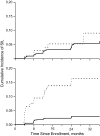Invited commentary: Human papillomavirus infection and risk of cervical precancer--using the right methods to answer the right questions
- PMID: 20007675
- PMCID: PMC2878105
- DOI: 10.1093/aje/kwp392
Invited commentary: Human papillomavirus infection and risk of cervical precancer--using the right methods to answer the right questions
Abstract
Epidemiologists are well aware of the negative consequences of measurement error in exposure and outcome variables to their ability to detect putative causal associations. However, empirical proof that remedying the misclassification problem improves estimates of epidemiologic effect is seldom examined in detail. Of all areas in cancer epidemiology, perhaps the best example of the consequences of misclassification and of the steps taken to circumvent them was the pursuit, beginning in the mid-1980s, of the human papillomavirus (HPV) infection-cervical cancer association. The stakes were high: Had the wrong conclusions been reached epidemiologists would have been led astray in the search for competing hypotheses for the sexually transmissible agent causing cervical cancer or in ascribing to HPV infection a mere ancillary role among many lifestyle, hormonal, and environmental factors. The article by Castle et al. in this issue of the Journal (Am J Epidemiol. 2010;171(2):155-163) provides a detailed account of the joint influences of improved HPV and cervical precancer measurements in gradually unveiling the strong magnitude of the underlying association between viral exposure and cervical lesion risk. In this commentary, the authors extend the findings of Castle et al. by providing additional empirical evidence in support of their arguments.
Figures



Comment on
-
Impact of improved classification on the association of human papillomavirus with cervical precancer.Am J Epidemiol. 2010 Jan 15;171(2):155-63. doi: 10.1093/aje/kwp390. Epub 2009 Dec 10. Am J Epidemiol. 2010. PMID: 20007673 Free PMC article.
Similar articles
-
Human papillomavirus: epidemiology and public health.Arch Pathol Lab Med. 2003 Aug;127(8):930-4. doi: 10.5858/2003-127-930-HPEAPH. Arch Pathol Lab Med. 2003. PMID: 12873163
-
Oncogenic human papilloma virus and cervical pre-cancerous lesions in brothel-based sex workers in India.J Infect Public Health. 2008;1(2):121-8. doi: 10.1016/j.jiph.2008.09.001. Epub 2008 Nov 12. J Infect Public Health. 2008. PMID: 20701853
-
Oncogenic Human Papillomavirus Infection and Genotype Characterization among Women in Orodara, Western Burkina Faso.Pak J Biol Sci. 2016;19(7):306-311. doi: 10.3923/pjbs.2016.306.311. Pak J Biol Sci. 2016. PMID: 29023032
-
[Anal cancer and human papillomaviruses: a perspective based on the cervical cancer model].Gynecol Obstet Fertil. 2010 Apr;38(4):250-4. doi: 10.1016/j.gyobfe.2010.02.003. Epub 2010 Apr 1. Gynecol Obstet Fertil. 2010. PMID: 20362481 Review. French.
-
The epidemiology of human papillomavirus infections.J Clin Virol. 2005 Mar;32 Suppl 1:S16-24. doi: 10.1016/j.jcv.2004.12.008. J Clin Virol. 2005. PMID: 15753008 Review.
Cited by
-
Commentary: Quantifying the impact of bias to inform quality assessments in systematic reviews: The case of perchloroethylene and Non-Hodgkin's lymphoma.Glob Epidemiol. 2022 Oct 17;4:100090. doi: 10.1016/j.gloepi.2022.100090. eCollection 2022 Dec. Glob Epidemiol. 2022. PMID: 37637019 Free PMC article. No abstract available.
-
The road ahead for cervical cancer prevention and control.Curr Oncol. 2014 Apr;21(2):e255-64. doi: 10.3747/co.21.1720. Curr Oncol. 2014. PMID: 24764711 Free PMC article.
-
Turning disciplinary knowledge into solutions.J Adolesc Health. 2013 May;52(5 Suppl):S98-102. doi: 10.1016/j.jadohealth.2013.02.015. J Adolesc Health. 2013. PMID: 23601619 Free PMC article.
References
-
- Franco EL, Olsen J, Saracci R, et al. Epidemiology's contributions to a Nobel Prize recognition. Epidemiology. 2009;20(5):632–634. - PubMed
-
- Schiffman MH, Bauer HM, Hoover RN, et al. Epidemiologic evidence showing that human papillomavirus infection causes most cervical intraepithelial neoplasia. J Natl Cancer Inst. 1993;85(12):958–964. - PubMed
-
- Franco EL. The sexually transmitted disease model for cervical cancer: incoherent epidemiologic findings and the role of misclassification of human papillomavirus infection. Epidemiology. 1991;2(2):98–106. - PubMed
-
- Franco EL. Statistical issues in human papillomavirus testing and screening. Clin Lab Med. 2000;20(2):345–367. - PubMed

